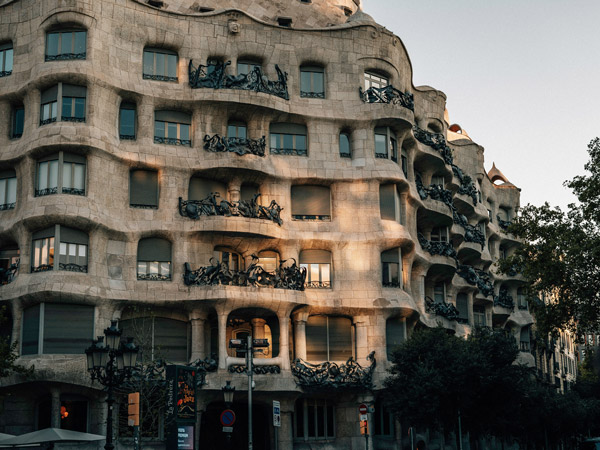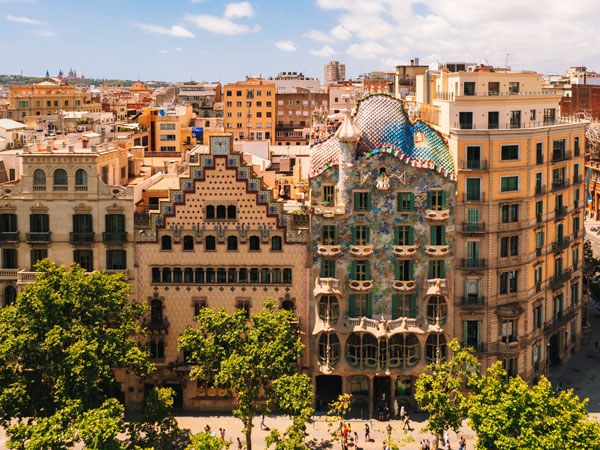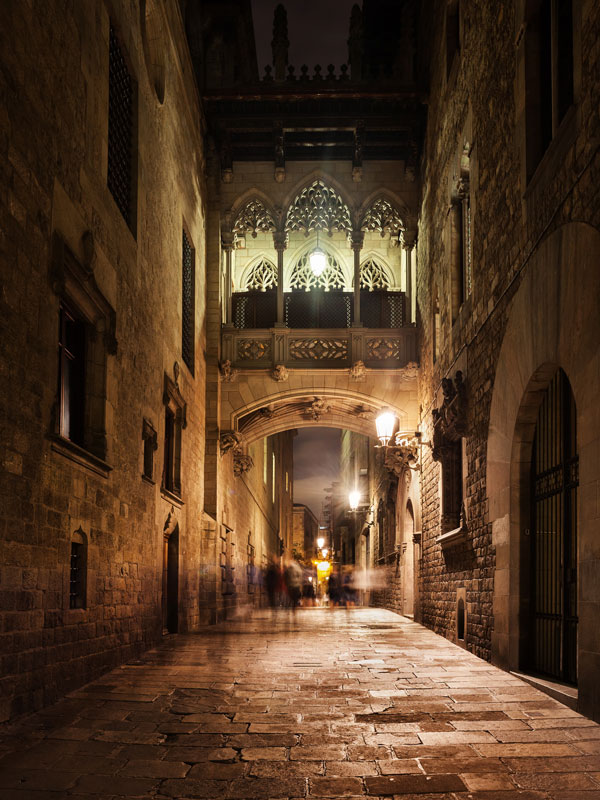The 19 best things to do in Barcelona


We love Las Ramblas and La Sagrada Familia, but it’s time to venture into new territory.
Despite other Spanish cities competing for our affection, Barcelona continues to bewitch us. From its beaches up all the way into the hills and the city in between, there is so much to spend your time doing.
To help you experience as much as you can, we’ve laid out the top things to do in Barcelona.
1. Savour La Sagrada Familia
It may be the obvious pick, but La Sagrada Familia still deserves to top any list. Building of this giant Catholic church began in 1882 and the beloved son of Barcelona, the architect Antoni Gaudí, took over the work soon after. Infamously, the construction is still ongoing.

La Sagrada Familia is one of Spain’s most famous landmarks. (Image: Krivinis via Getty Images)
While you can check out the soaring pointed steeples and fiddly and intricate facades from the outside, inside the rainbow of lights and angular columns are a sight to behold. Make bookings in advance.

After 140 years, La Sagrada Familia is finally nearing its completion. (Image: Danandnatty via Getty Images)
2. Stroll in Park Güell
Gaudí’s other most famous work in Barcelona is Park Güell, which is perched at La Salut in Gràcia. Across its gardens, you can sit by the bright mosaic shards of Plaça de la Natura, wander in its curving viaducts of stone, and relax among the plant life of the Austria Gardens.

Park Güell is the grandest park in Barcelona. (Image: Ihor_Tailwind via Getty Images)
Like La Sagrada Familia, Park Güell displays Gaudí’s unique interpretation of naturalism meets art nouveau and is a UNESCO World Heritage site. The cost of entry is approximately €10 ($16.50) and is subject to availability.

Park Güell is a UNESCO World Heritage site. (Image: OlyaSolodenko via Getty Images)
3. Don’t neglect Gaudí’s other work
Gaudí left his mark all over Barcelona. There’s the organic, skeletal shape of Casa Batlló with its glowing facade of stone, glass and ceramics.

Casa Batlló welcomes one million visitors per year. (Image: Ruggiero Calabrese)
And Casa Milà, or La Pedrera, is recognisable by its rolling waves of stone.

Casa Milà is another impressive Gaudí masterpiece in Barcelona. (Image: David Russeler)
Then there’s Casa Vincens, the first work by Gaudí, and one of the least-known displays of his architectural brilliance, making for a relaxed afternoon gazing on the decorative paper mâché dates and flowers, glowing windows and rainbow-lined circular wall fountain.

Casa Batlló is located at number 43 on Paseo de Gracia, a street that, in the past, connected the city to Vila de Gracia. (Image: pawel.gaul via Getty Images)
4. Try seasonal Catalan food
Most ‘to do in Barcelona’ lists will have eating paella and tapas at the top. But why not make the food of Catalonia, the region Barcelona is in, a priority? In winter, book a calçotades feast, where you dip a type of mild onion (called calçots) into bowls of salsa. Bibs and gloves are provided for the inevitable spillage.

Book a calçotades feast in Barcelona. (Image: nito100 via Getty Images)
When Easter arrives, the La Mona de Pascua cake, which is usually served with decorative chocolate and figures, is on the table. In summer, barbecued sardines can be found everywhere.

Try barbecued sardines in summer. (Image: MEDITERRANEAN via Getty Images)
The traditional feast of chestnuts, panellets (balls of almond paste covered in pine nuts) and sweet potatoes are at the feast of La Castanyada on Halloween.
All year round you can order La Bomba in tapas bars, a ridiculously scrummy Catalan treat that consists of a potato croquette, beef mince with aioli and brava sauce.

Try panellets at the feast of La Castanyada. (Image: Xavier Lorenzo via Getty Images)
5. … and Spanish food
Listen. Just because it is not from the specific region of Catalonia, doesn’t mean we don’t want to have food from other Spanish regions. Seafood paella from Valencia, croquettes that originated in France and empanadas that are thought to be from Galicia are all delicacies we can’t help but devour most of the time we’re in Barcelona.

Seafood paella is a Spanish icon. (Image: bobakphoto via Getty Images)
6. Sip on some Cava
The French town of Champagne has Champagne, the Italian village of Prosecco has Prosecco and Catalonia has Cava. Whether it’s accompanying a long tapas lunch or drunk as a pre-dinner treat, this sparkling white made in the traditional method is the way to go.

Enjoy some Cava in Barcelona. (Image: Alisa Reutova)
7. Share time over a vermouth aperitif
Having a drop of vermouth at midday when it’s time to ‘fer un vermu’, or ‘do a vermouth’, is a cherished tradition in Barcelona. Served on the rocks with a slice of orange and olives, this beloved botanical and herb-tasting drink is also acceptable as a warm-up to dinner.

Do a vermouth at midday. (Image: Gaby Yerden)
8. Get lost in the galleries
If you wish to revel in the works from what is considered by many to be the greats of 20th-century Spain, Barcelona has you covered. The Museu Picasso – or Picasso Museum – has an enormous number of the late artist’s works. Over at the Joan Miró Foundation, you can find many pieces from the Barcelona-born artist, which cover his artistic journey from surrealism to fauvism and expressionism.

The Museu Picasso has an enormous number of the late artist’s works. (Image: Miquel Coll Molas)
The Museu Nacional d’Art de Catalunya (MNAC) is home to a wide range of Catalan art and design from the late 1800s to early 1900s, as well as one of the world’s most impressive collections of Romanesque art.

Museu Nacional d’Art de Catalunya showcases art from the late 19th century. (Image: Kristijan Arsov)
9. Ramble on Las Ramblas
A tree-lined street that takes in Barcelona’s main thoroughfare from Plaça de Catalunya, Las Ramblas is well-known for its ornate buildings, paveside cafes and restaurants and exuberant atmosphere.

Las Ramblas is a Barcelone must-see. (Image: Nikada via Getty Images)
While it can get busy in tourist season (and you definitely should keep your eye on your pockets), sights like a mosaic by Joan Miró and La Boqueria market, make it well worth seeing.

Las Ramblas can get busy so keep your wits about you. (Image: Eva-Katalin via Getty Images)
10. Feast at a food market
Speaking of La Boqueria, the world-famous food market that is massively popular with visitors today, has roots that go back centuries. While the food here is far pricier than you’d get in a local tapas bar, the place is buzzing and a good place to see everything all at once’.

Shop your way around La Boqueria food market. (Image: Martijn Vonk)
If you want a low-key market, the Santa Caterina Market has a more local feel, with better prices and a smattering of restaurants.

Santa Caterina Market is a much quieter market. (Image: JackF via Getty Images)
11. Go (not too) wild in the Gothic Quarter
The Barri Gòtic is one of the oldest parts of the city. It isn’t hard to believe this when you’re surrounded by narrow, winding streets, so tall and slim it can almost feel like the sky is about to be blocked by ancient buildings.

Walk along the old streets and alleys in the Gothic Quarter. (Image: bbsferrari via Getty Images)
With so much to see, like the El Call Jewish neighbourhood, the Catedral La Seu of Barcelona and of course, Las Ramblas, a visit here at least once is a must.
If you go out here at night though, watch out for pickpockets. As one Barcelona resident put it: “Pickpockets in Barcelona go after the weak and the drunk”.

The Gothic Quarter is notorious for pickpockets. (Image: Artur Bogacki via Getty Images)
12. Barcelona Cathedral
While not as famous as La Sagrada Familia, the Catedral La Seu of Barcelona (also known as Barcelona Cathedral) is far older. Built way back in the 13th century, visitors today can check out this historical cathedral’s distinctive Catalan Gothic style and Romanesque interiors.
You can even take a moment in its palm-tree-lined garden, complete with an orange tree, fountain and white geese swimming calmly in the courtyard’s pond.

The impressive Barcelona Cathedral dates back to the 13th century. (Image: Maxim Morales via Getty Images)
13. Relax at a plaça in Gràcia
The neighbourhood of Gràcia is one of the prettiest and most laid-back areas to spend a day or two soaking up the local culture. Spend an afternoon sitting at a little table in the shade of a tree in a square, such as the Plaça del Sol, Plaça de la Virreina or Plaça de la Vila de Gràcia.
Once you have a bomba and a cold glass bottle of Coca-Cola at your elbow, pull out a book and listen out for soft guitar music from street buskers.

Plaça de la Virreina is the meeting point for neighbourhood locals.
14. Sift through at the flea market
A flea market that is a jumble sale in the truest sense of the word, Mercat dels Encants has been a place of trade for around 700 years.
Today, at what is thought to be one of Europe’s oldest markets, 300 or so stallholders pull at the threads of your attention with everything from electronic instruments, underpriced leather jackets, rare decorative arts and old dolls, to one-of-a-kind antiques, scraps of lace, haberdasheries and abandoned books. Bring your energy and leave with a unique souvenir.

The glass roof at Mercat dels Encants reflects chaos and beauty. (Image: Eloi Montardit)
15. Climb the mountain of Montserrat
Want a day away from the busyness of Barcelona? The mountain of Montserrat has hypnotising crags and oddly shaped stone massif, which in some lights looks like sandcastles.

Pastel hues paint the sky above the mountain of Montserrat. (Image: Ian Kelsall)
It is accessible via an hour train ride from Plaça España station, with a ride up the rack railway to the Benedictine Monastery Santa Maria de Montserrat. Afterwards (if you have the energy) take the cog railway up to the summit to try out some of the hiking trails.

The craggy peaks of Montserrat are mesmerising. (Image: Polina Kocheva)
16. Take the Cable Car to Montjuïc
Closer to the city itself is the hill of Montjuïc. While nowhere near as impressive in size or geological value as the Montserrat mountain range, Montjuïc offers some impressive views over the city and out to the harbour on a clear day. Up here, you can explore the 17th-century Castle of Montjuïc, the Fundació Joan Miró and the Museu Nacional d’Art de Catalunya.

Montjuïc offers some impressive views over the city. (Image: Valdemaras d)
17. Party at a seasonal festival
If you time your visit right, you can experience some wild festivities including the Santa Eulàlia Festival: the winter festival of Barcelona. In districts like the Barri Gòtic, giant puppets totter on human legs, disguised as fantastical shapes like dragons, saints, kings and farm animals.
Another festival, Carnaval, sees celebrations all over Spain, seven weeks after the first full moon. In Barcelona, you will see masked figures in every costume imaginable, celebrating and dancing around the parade led by the rambunctious El Rei Carnestoltes, or The Carnival King. In short, check the festive calendar before you book your Barcelona trip.

Carnaval sees celebrations all over Spain, seven weeks after the first full moon.
18. Create time for live music
Live music is a must for anyone looking to get closer to the heart and lifeblood of those who live in the city. Look for it in small bars and local venues like the Soda Acústic jazz bar in Gràcia, the Jamboree performance club in the Gothic Quarter and the music festivals of Harlem Jazz Club in the old town.

Join in the fun at the Harlem Jazz Club.
19. Recover at the beach
After all that, it’s time for a siesta. And if it’s not too hot at the traditional 2pm slot, make for the sand to swim, sleep and repeat. Among the most famous are Barceloneta Beach and Sant Sebastià Beach, and the LGBTQIA+ and family-friendly town of Sitges, further afield from town.

Soak up some sunshine at Barceloneta Beach. (Image: Aimee Tavares via Getty Images)













LEAVE YOUR COMMENT